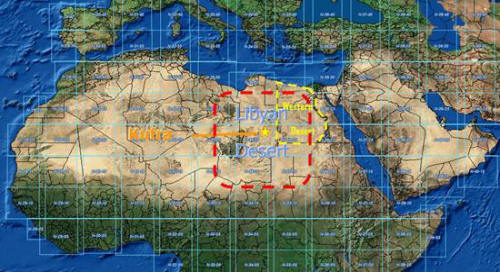|
The article assumed
certain knowledge of terms that Ahmed Bey has had little time to
explain in this article. So we'll include few here. If you like to add to it,
please email
me.
Here's a table of the
entries:
Libyan Desert
Arabic Desert (a.k.a.
Eastern Desert)
Berbers
Pictographs
Cyrenaica (a.k.a. Eastern
Libya)
Bedouin
Libyan Desert

Not
only in Libya as some might think. It includes the entire Western Desert
of Egypt too. The Libyan Desert seems to be between latitudes of 15°
and 30° North and longitudes of 15°
and 30° East where Kufra oasis is
approximately at its center. In ancient Egypt, it may have been the
label for the entire Sahara bordered by Nile on the east and the Atlantic
at the west. Libya is actually an ancient Egyptian
word meaning the 'Berber Desert' (Libu is a name of a Berber
tribe in ancient Egypt) that has been popularized by Ptolemy of
Alexandria to Muslims and the West. In contrast, the Egyptian word for
Eastern Desert is 'Arabic Desert' because it was void of Berbers and
seemed to have been occupied by Semitic (Arabic) Bedouins throughout the millennia. Libyan
and Arabic Desert have been in use since ancient times. Egyptian
Government may have changed the name (perhaps during British occupation)
because the word Libyan and Arabic took new meanings upon drawing new
borders and to emphasize the Egyptian control on the two deserts away
from the Ottomans.
See
Arabic Desert,
and Berbers
Arabic Desert
(a.k.a. Eastern Desert)
Rather than the flat and vast
Western Desert dotted by oases, the Eastern Desert is mountainous with
long beaches on Red Sea. Both Arabic Desert (al-sa7ara2 al-3arabeya) and
Eastern Desert are names by the Egyptian governments in ancient times as
well as now. Geographically (by scientists) it's part of the Red Sea
desert stretched from Sinai to Somalia with similar mountainous nature
and changing tribes from region to another. Although the Arabic
part of this desert is evident in its northern stretches, the southern
parts are occupied by Beja (Beshareya and Ababda tribes) who are neither
ethnically nor culturally Arabic.
See also,
Libyan Desert
Berbers
People who speak an Afro-Asiatic
language called Tamazight (like the language of Siwans). Famous Berbers
are Zeinedine Zeidane, Tarek Ibn Zeyaad, elZanati
Khalifa, and all your friends from Siwa. Berbers occupy all the land
from Egyptian Western Desert to Morocco and are a hybrid of races
themselves (black and Germanic blondes perhaps from prehistorical
times). Most of the 'Oases' in Western Desert are previously Berbers who
converted to Arabic language in the last few hundred years. Only Siwa
remained out of the Nile Valley influence because of its relative
remoteness. Their language along with Semitic (both seem to come from
same root called Afro-Asiatic family of languages) are the major
components of the ancient Egyptian language. Examples of Siwi language
are like "I Love You" ð "nish ikhsashem",
"bread" ð "tghara", "one"
ð "ejnii", "two" ð
"sen", "water" ð "amaan" and "Hi"
ð "tel-7al-nek".
Pictographs
Rock-art
Cyrenaica (a.k.a. Eastern
Libya)
This is the Roman/Byzantine name
for eastern half of Libya today. Although this seems to have extinct in
native languages, the name persists in many European languages that even
today some Western scholars still use in their scientific writing to
indicate Libyan tribes. The Western half was called Tripolitania during
Roman times and was extended to Tunisia.
See also
Berber, Libyan Desert.
Bedouin
Mainly used for nomads of Arabia
and North Africa (you don't hear of Australian Bedouins). There are two
ways of using the word. One in existing lifestyle and another of lineage
(ancestral heritage). That should explain why some sedentary villagers
who work with agriculture or trade are still called Bedouins
(3arab-7eitaan in Egypt and ahl-alQura in Quran) although they are not
nomads at all. "ahl-al-wabar" in Arabia and "3arab-elkheish" in Egypt
are other synonyms. Other spellings in English are Bedawin, and
Beduin.
 
|
